
A domino is a small, flat, rectangular block, each side bearing from one to six dots or pips, that is used as gaming object. Its use as a game has given rise to various activities including games involving the positioning of dominoes in lines and angular patterns, and those based on the arrangement of dominoes into overlapping rows and columns. The pieces can also be used to form 3D structures such as towers and pyramids. They are made of rigid material such as wood or bone, and have been used for centuries. In the past, they were also made of ivory and silver lip ocean pearl oyster shell (mother of pearl) with contrasting black or white pips inlaid or painted. Most current sets are made of plastic and manufactured in a variety of colors.
There are two major types of domino games, blocking and scoring. In blocking games, each player in turn places a domino edge to edge against an opponent’s tiles in order to add to or extend a line of dominoes already on the table. Each tile must have the same number of pips on both sides; the first person to play a domino in this fashion is said to “take a turn”. If the players cannot find a matching piece, they must “chip out” (play their last domino) and play passes to the next player.
In scoring games, each player attempts to build a chain of dominoes that is either the longest possible or has some specified total. The player who achieves either of these objectives wins the game. Usually, each tile has two suits of numbers: those that can only be found on the end of a domino and those that appear both on the ends and in the center of a domino.
Dominoes are often used to create a piece of art. They can be arranged in straight or curved lines, grids that form pictures when they fall, and 3D structures such as towers and pyramids. Artistic domino arrangements are also sometimes made using other materials such as clay or frosted glass.
The domino effect is a common phrase that describes a single action that leads to many greater consequences. Whether you’re a plotter who writes a detailed outline or an intuitive writer who composes a manuscript off the cuff, it’s important to consider how each action in your story will impact the next.
To help you keep track of this, I recommend creating a domino diagram, where each part of your story is represented by a domino. This will allow you to see how your plot beats are connected, and will ensure that each domino has the right impact. You can even take this concept to a more advanced level by using a domino design software such as Domino Designer, which allows you to plan out a complex layout and calculate how many dominoes you need for your project. Try it out! You might be surprised at how much more quickly you can write your book when you know how each domino should fall.